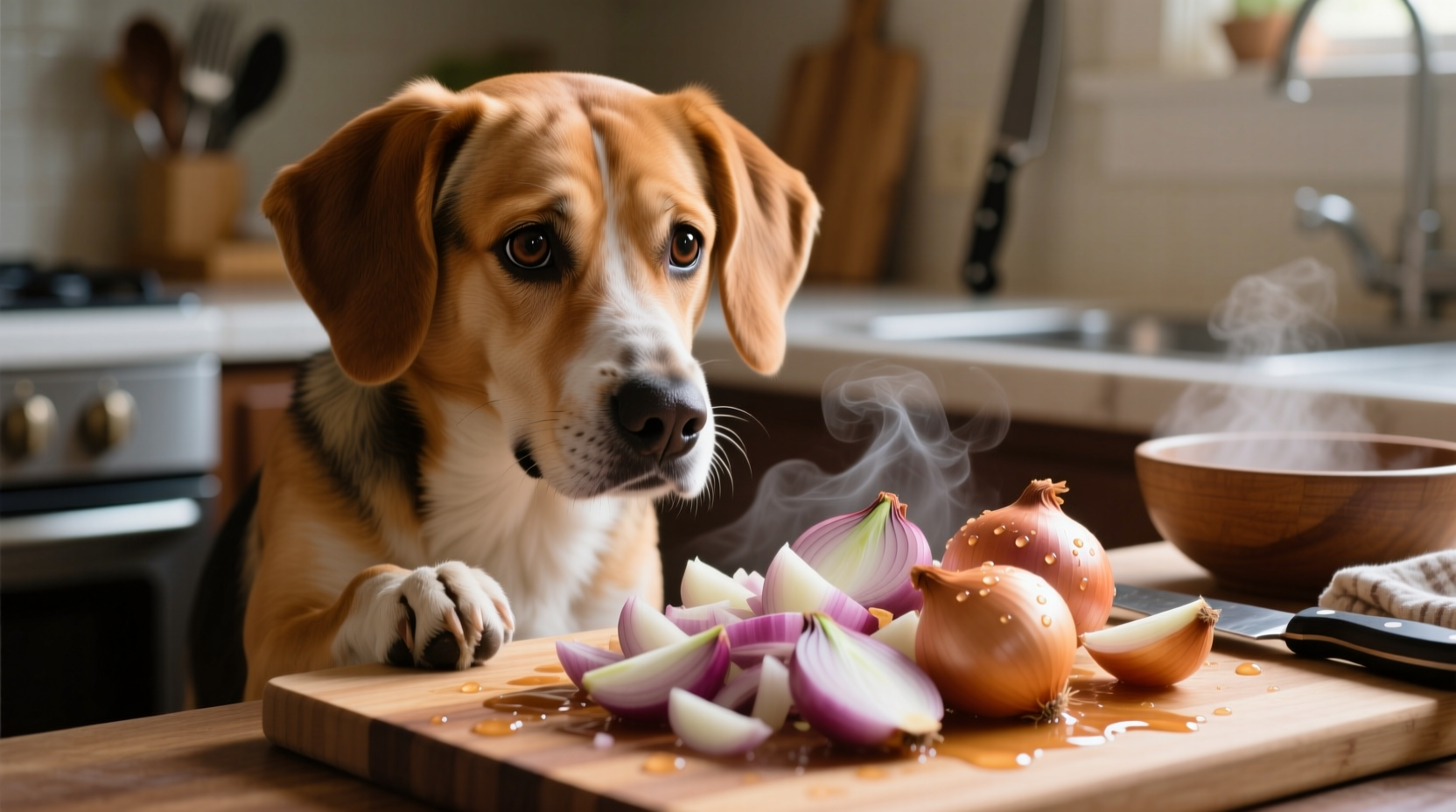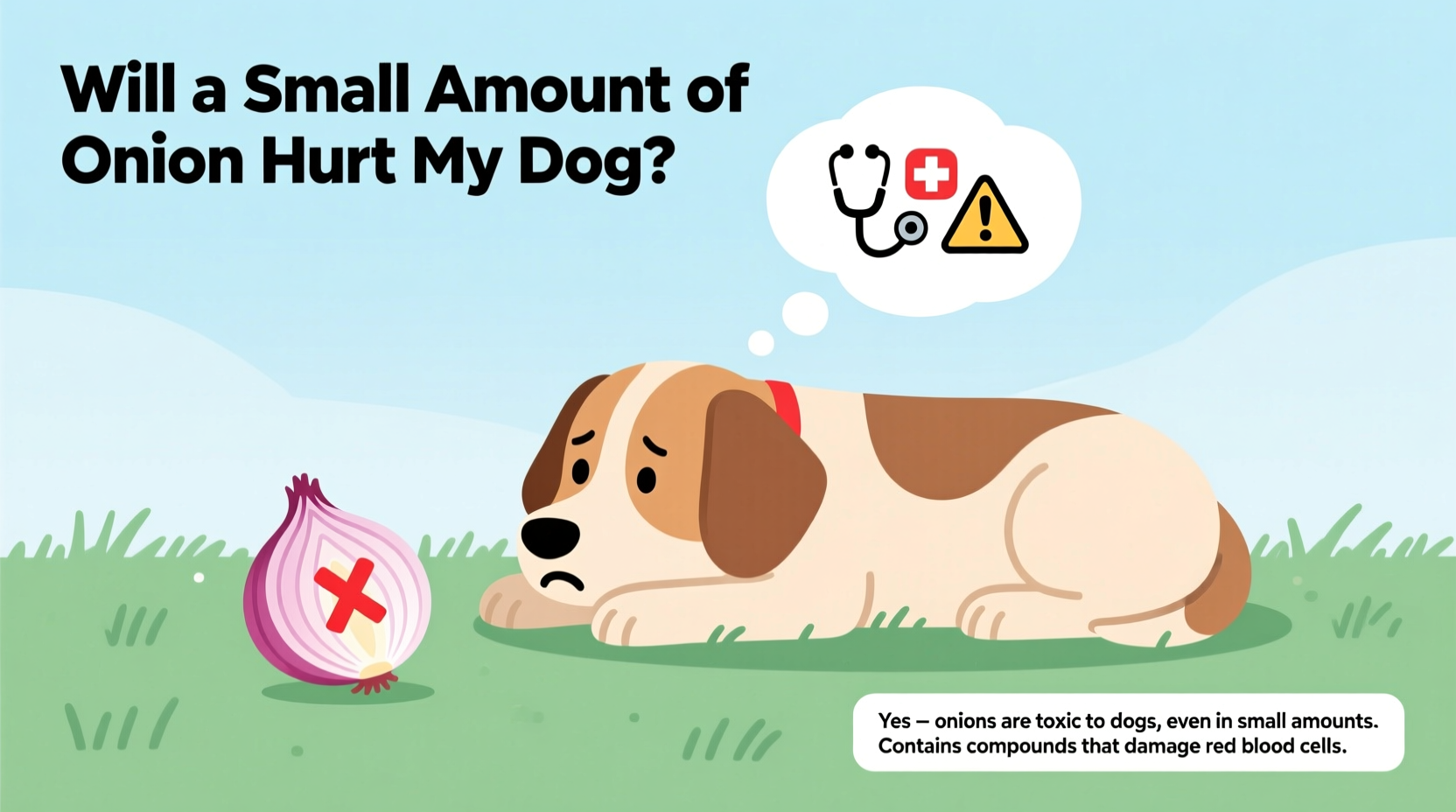Yes, even a small amount of onion can hurt your dog. Onions contain N-propyl disulfide, which damages red blood cells and can lead to life-threatening anemia. There is no safe amount—any onion consumption requires veterinary attention.
Discovering your dog has eaten onion triggers immediate concern. As someone who's researched food chemistry and its biological impacts through years of culinary science study, I understand how seemingly harmless kitchen ingredients can pose serious risks to pets. This guide provides clear, actionable information based on veterinary toxicology research to help you protect your canine companion.
Why Onions Are Dangerous for Dogs
Onions belong to the Allium family (including garlic, leeks, and chives), containing organosulfur compounds that oxidize hemoglobin in red blood cells. This creates Heinz bodies—abnormal structures that make red blood cells fragile and prone to rupture. The resulting hemolytic anemia reduces oxygen delivery throughout your dog's body.
"Dogs lack the enzyme necessary to metabolize these compounds safely," explains Dr. Tina Wismer, Senior Director at ASPCA Animal Poison Control Center. "Unlike humans, even small exposures can trigger a toxic reaction that builds over days."

How Much Onion Is Toxic?
The toxic dose varies by dog size and individual sensitivity. Research from Cornell University College of Veterinary Medicine indicates:
| Dog Weight | Minimum Toxic Dose | Severe Risk Level |
|---|---|---|
| Under 10 lbs | 5 grams (1/8 onion) | 20 grams |
| 10-50 lbs | 15 grams (1/4 onion) | 60 grams |
| Over 50 lbs | 30 grams (1/2 onion) | 120 grams |
These thresholds represent minimum dangerous amounts. Some dogs develop symptoms after smaller exposures, especially Japanese breeds like Shiba Inus and Akita that have genetic predispositions to hemolytic anemia.
Symptom Timeline: What to Watch For
Onion toxicity symptoms often appear 24-72 hours after ingestion as damaged red blood cells accumulate. Recognizing these progression stages helps determine urgency:
- 0-12 hours: Vomiting, diarrhea, abdominal pain (if recent ingestion)
- 12-24 hours: Lethargy, decreased appetite, rapid breathing
- 24-72 hours: Pale gums, dark urine (hemoglobinuria), weakness, collapse
- 72+ hours: Severe anemia requiring blood transfusion
A 2022 study published in Veterinary Sciences tracked 147 onion-exposure cases, finding 68% developed clinical symptoms even with exposures below established toxic thresholds. This demonstrates why veterinary consultation is essential regardless of apparent amount consumed.
Immediate Action Plan
If your dog ingested onion, follow these evidence-based steps:
- Calculate exposure: Weigh any remaining onion or estimate amount consumed using the table above
- Contact professionals immediately: Call ASPCA Animal Poison Control (888-426-4435) or your veterinarian—don't wait for symptoms
- Provide details: Note exact time of ingestion, dog's weight, and any symptoms observed
- Follow veterinary instructions: Treatment may include induced vomiting (within 2 hours), activated charcoal, or hospitalization for monitoring
"Time is critical with onion toxicity," emphasizes Dr. Wismer. "Early intervention prevents red blood cell damage from progressing to life-threatening levels."
Preventing Future Incidents
Protect your dog with these practical strategies:
- Store onions and garlic in closed cabinets away from curious noses
- Dispose of food scraps in secured outdoor bins
- Train "leave it" command using positive reinforcement methods
- Check pet food ingredients for hidden onion powder (common in some commercial broths)
- Inform all household members about toxic foods using visual reminders
Common Misconceptions Clarified
Many dog owners believe:
- "Cooked onions are safe" – Cooking concentrates toxic compounds
- "Only large amounts matter" – Cumulative exposure from multiple small servings can be dangerous
- "My dog ate it before with no issues" – Sensitivity can develop over time
The American Kennel Club's Canine Health Foundation confirms that no amount of onion provides nutritional benefit to dogs, making complete avoidance the only safe approach.
Can a single small bite of onion kill a dog?
While a single small bite rarely causes immediate death, it can trigger hemolytic anemia that becomes fatal without treatment. Even minor exposures require veterinary assessment to prevent complications.
How long after eating onion will my dog show symptoms?
Symptoms typically appear 24-72 hours after ingestion as damaged red blood cells accumulate. Early signs include vomiting and lethargy, progressing to pale gums and dark urine as anemia develops.
Is onion powder as dangerous as fresh onions for dogs?
Yes, onion powder is actually more concentrated and dangerous. One teaspoon of onion powder equals one whole onion in toxicity. Check ingredient labels on baby food and broths, which often contain hidden onion powder.
What should I do if my dog ate onion but seems fine?
Contact your veterinarian immediately regardless of current symptoms. Blood tests 24-48 hours post-ingestion can detect early red blood cell damage before visible symptoms appear, allowing preventative treatment.
Are some dog breeds more sensitive to onion toxicity?
Yes, Japanese breeds like Shiba Inus and Akitas have genetic predispositions to hemolytic anemia, making them more vulnerable to onion toxicity. However, all dog breeds lack the enzyme to safely process onion compounds.











 浙公网安备
33010002000092号
浙公网安备
33010002000092号 浙B2-20120091-4
浙B2-20120091-4